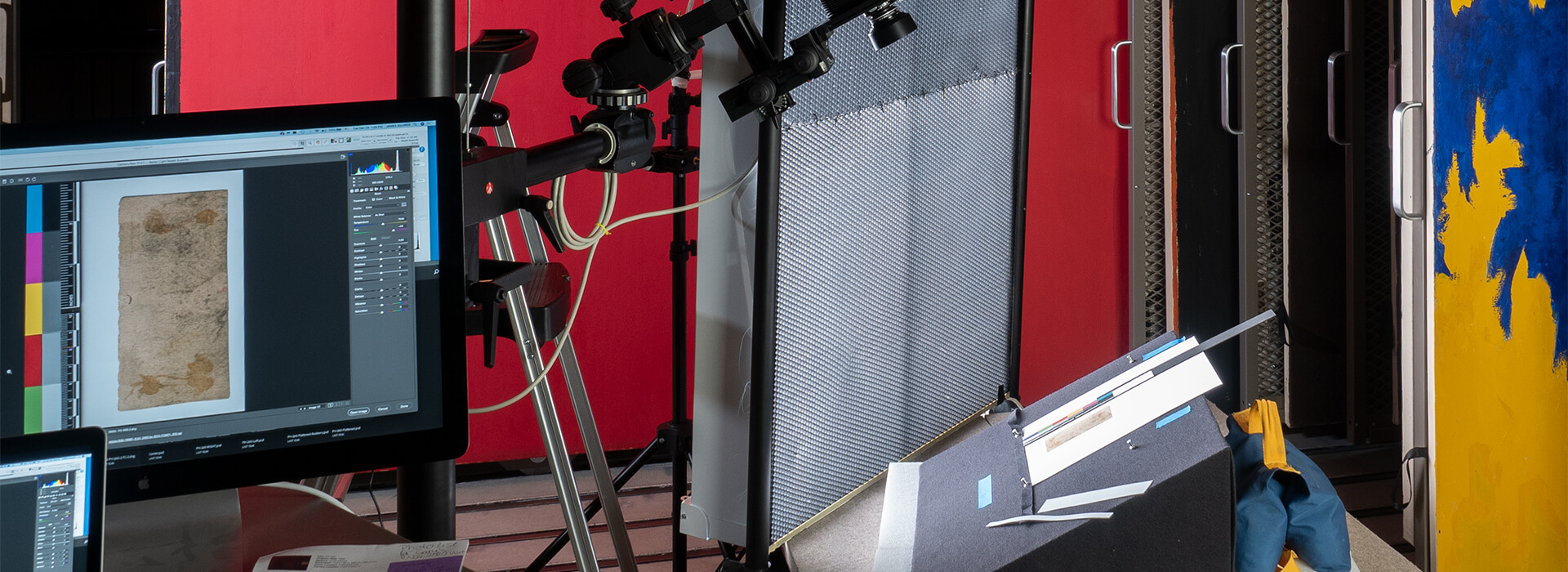The monumental project to photograph the Clyfford Still Museum collection with high-resolution images has been ongoing for years and involves many moving parts and staff members. The process begins with a running list of works that need to be photographed including works that are newly matted or stretched, have been treated by the conservators, are needed for an exhibition or publication, or need to be reshot.
Producing high resolution images of Still’s artworks begins with a running list of works that need to be photographed. Any works that are newly matted or stretched, have been treated by the conservators, are needed for an exhibition or publication, or need to be reshot for other reasons go on the list. Typically, the Museum puts between 75-100 works on a list for each week that the photographer is in residence.
To capture the surface and texture of Still’s artworks, photographer Gary Regester shoots them with a large format view camera and special lenses designed to photograph images in a huge format, with file sizes around 200-250 megabytes. The high resolution is what allows users to zoom in closely and still maintain the detail of the artworks. The team also uses a manual focus on the camera and a special setup using a mirror. “Because we’re getting such high resolution, and that ability to zoom in, focus has to be dead on,” said CSM Conservator James Squires. “Otherwise, when you start zooming in, you’re going to see how far you’re off and it’s going to be blurry.”
A key component to CSM’s high resolution photography is using the right lighting. The team spaces the artificial lighting in such a way that is even larger than the artwork for detail and evenness across the surface. Any work larger than about six feet by eight feet must be shot in the galleries. Because of the amount of time needed to make a digital scan of a large painting (10-15 minutes per scan), natural light from the gallery ceiling can still be a problem on days when there are clouds passing overhead.
The team shoots smaller works on canvas or works on paper in south painting storage or the Conservation Lab. When imaging the works on paper, CSM uses lighting techniques typically used by commercial photographers that simultaneously evenly lights the surface while subtly highlighting surface texture and detail. The technique essentially plays with the physics of light by using a white honeycomb-like grid over the light sources to diffuse the light in a way that casts it evenly over the surface of the artwork.
A typical photography day in the galleries can consist of six to eight works on canvas, or smaller works can number 24 to 30 in a day. Works on paper typically take eight to 10 minutes each and the paintings typically take 12-15 minutes each.
After images are photographed, CSM retains different digital formats on a server and in Luna, the Museum’s Digital Asset Management System. The Museum catalogs information about the artwork itself in Qi, a Collection Management System. The two systems communicate with each other by exchanging information and digital files push information to a third system, which is the public portal visitors use to view the online collection.
More than 2,500 artworks in the collection have gone through the high-resolution photography process. Approximately 450 more artworks still need to be photographed, but those also include the verso (back) sides of paintings and works on paper. If an artwork has changed dramatically on its own over time after it has been stretched, or has undergone conservation treatment, the Museum may reshoot it again. The original image then becomes a historical document for the institution and the new image will then replace the old one in the online collection.
According to the collections team, there are many reasons why it is important to photograph the collection with high resolution images. Besides the basic purpose of documentation and database entries, having high resolution photography helps CSM staff understand changes to works over time. “Because so many of the canvases were rolled when they were dry to the touch, but still wet, they are continuing to change, and so it is important to capture that moment in time of the works, to document it for the institution,” said Squires. “Subsequently, future generations can go look at the work and reference it, which creates a better context of our decision-making process and our stewardship of the collection.”
Photographing the collection also helps with exhibition planning processes, especially in a COVID-19 remote-working world. High resolution photographs help with curating exhibitions by developing the first iteration of a checklist; pulling high resolution images into the Virtual Gallerie software to see how everything works together; and providing access to guest curators who may not be able to visit the Museum.
Eventually, all of the final object photographs will also be published in the catalogue raisonné.
Ultimately, the importance of photographing the collection comes down to access, which is a large part of the Museum’s mission. Providing access to high-resolution photographs through our website and publications helps the public and scholars understand Still’s mark making, paint handling, and artistic process.

